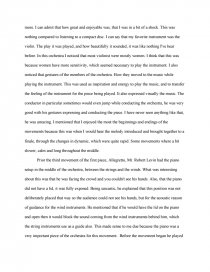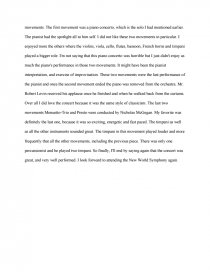Concert Critique of Mozart and the Height of Classicism
Essay by review • October 24, 2010 • Essay • 1,287 Words (6 Pages) • 2,019 Views
Essay Preview: Concert Critique of Mozart and the Height of Classicism
On Sunday, December 07, 2003, I attended the Mozart and The Height of Classicism concert that was held in the Lincoln Theater of the New World Symphony orchestral academy. Conducted by Nicholas McGegan featuring pianist Robert Levin. There were two pieces of music during this concert, one of the movements was performed by the pianist alone as a solo, Mr. Robert Levin. The program's title was Wolfgang Amadeus Mozart, Chaconne from Idomeneo. The first piece was Concerto No. 24 in C minor for Piano and Orchestra, K. 491, Allegro, Larghetto, and Allegretto. The second piece was Symphony No. 36 in C major, K.425, "Linz", Adagio-Allegro spiritoso, Andante, Menuetto-Trio, and Presto. This concert was unique in that the focus seemed to be as much on the instruments as in the music itself. As the pianist and conductor expressed the form of improvisation as Mozart did, which I will explain further on my critique.
The concert began promptly at 3pm, when the conductor Nicholas McGegan entered the stage with the full theater clapping, along all the members of the orchestra. All the men and women in the orchestra including the conductor were wearing all black suits. Prior to his entrance I noticed that the orchestra began to play, it was obvious that the concert had not begun, so I realized that they were just toning their instruments. This also, happened when we returned from intermission. Being my first time to an orchestra I first thought that they were playing around with the instruments.
The Allegro part was very good. I found my self enjoying the most the beginnings and endings of the movements. It also sounded very happy, and bright. This one and Larghetto I enjoyed fully since it was the beginning of the concert. This was my first time attending an orchestral concert. I noticed how beautiful the music sounded and I began to appreciate it a lot more. I can admit that how great and enjoyable was, that I was in a bit of a shock. This was nothing compared to listening to a compact disc. I can say that my favorite instrument was the violin. The play it was played, and how beautifully it sounded, it was like nothing I've hear before. In this orchestra I noticed that most violinist were mostly women. I think that this was because women have more sensitivity, which seemed necessary to play the instrument. I also noticed that gestures of the members of the orchestra. How they moved to the music while playing the instrument. This was used as inspiration and energy to play the music, and to transfer the feeling of the instrument for the piece being played. It also expressed visually the music. The conductor in particular sometimes would even jump while conducting the orchestra, he was very good with his gestures expressing and conducting the piece. I have never seen anything like that, he was amazing. I mentioned that I enjoyed the most the beginnings and endings of the movements because this was when I would hear the melody introduced and brought together to a finale, through the changes in dynamic, which were quite rapid. Some movements where a bit slower, calm and long throughout the middle.
Prior the third movement of the first piece, Allegretto, Mr. Robert Levin had the piano setup in the middle of the orchestra, between the strings and the winds. What was interesting about this was that he was facing the crowd and you couldn't see his hands. Also, that the piano did not have a lid, it was fully exposed. Being sarcastic, he explained that this position was not deliberately placed that way so the audience could not see his hands, but for the acoustic reason of guidance for the wind instruments. He mentioned that if he would have the lid on the piano and open then it would block the sound coming from the wind instruments behind him, which the string instruments use as a guide also. This made sense to me due because the piano was a very important piece of the orchestra for this movement. Before the movement began he played a sample piece of C minor and D major, which is a symbolic note for the wind instruments like he said. He did this to get the audience in the mood for the sound. Promptly after the 5 minute introduction the orchestra began the movement by playing along. Not only did it get the audience, including my self in the mood for the following movement, but I think that without it I wouldn't have enjoyed or understood the piece the same.
Once the first piece ended the pianist,
...
...



